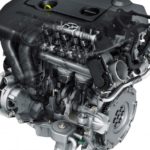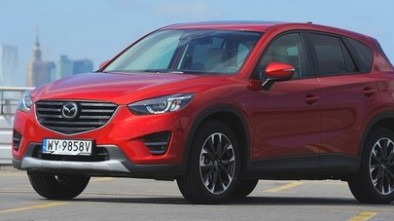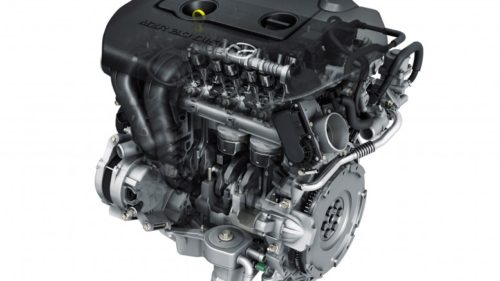Mazda 6 2002 - 2007 - boat, experiences, problems, crashes…
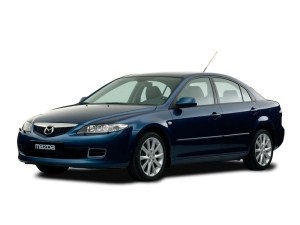
Mazda 6
The Mazda 6 is already at first glance a solid family car that meets all the requirements that a four-wheeler is intended for, primarily for family and longer journeys. The older Mazda may have been boring and unattractive, but this is not true of this model.
The Mazda 6 was created on the wings of the "zoom-zoom" philosophy, when Mazda literally turned the page, and set out on a modern and bold path. The Mazda 6 is the direct successor to the famous 626 model, which was made under that name in five generations from 1979-2002. It is also the ancestor of the new model numbering system in Mazda's range, since when the three-digit code marks (626) are extinguished, because now each Mazda series is marked with one digit (2/3/5/6, along with the CX and MX series). Equipped with a completely new series of petrol engines, with the MPS version introduced for the first time, along with Mazda's eternal RF diesel engine, it's no wonder that the Mazda 6 is the cornerstone of Mazda's new philosophy.
The Mazda 6 bears the GG mark for the 4dr and 5dr versions, while the station wagon bears the GY mark. Mazda has been very ambitious on everything or nothing, offering an extremely wide range of engines, ranging from 1800cc, 2000cc, 2300cc petrol to 2000cc diesel in two power variants. Later, a supply liner, the MPS 2300 cc direct injection turbo engine, was also introduced.
By the time the Mazda 6 came into being, Ford had a large stake in Mazda. This is directly evident in the sharing of platforms and mechanics, because Ford took over the Mazda's MZR series of gasoline engines under the name Duratec. At the same time, the Ford Mondeo and Mazda 6 are close mechanical models. With diesel engines, the game is a different story. Here, Mazda relies on its eternal and indestructible RF engine, which is originally from the GC Model 626, where it is constantly refined and refined, and versions were made with a compressor, turbo compressor, different valve timing to eventually get a common rail fuel injection in the latest batch fitted to the Model 6.
COMFORT - Mazda 6
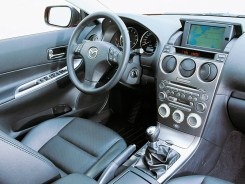
Mazda 6
The look of the Mazda 6 is appealing, at the same time with elegant and aggressive lines, the build quality is excellent, the materials and colors in the cabin are great. Even Mazda can be said to have reached the German level. The steering wheel is straightforward and precise, and the chassis is perfectly tuned, so the driving impression is phenomenal. The cabin is well insulated, the visibility is excellent and the drivers will be comfortably seated behind the wheel. Due to the abundance of space and high trunk, the Mazda 6 is not very clear when looking backwards.
There is plenty of room in the cabin, and as far as the trunk is concerned, the rear bench is easily folded down to give you even more floor space. The Mazda 6 comes well equipped even in the basic versions, and let's say the best-selling TS has everything you need, and more.
Suspension is a bit stiff at lower speeds, which you will especially feel in the city, but as soon as you catch the pace everything will smooth out, so we can say that the Mazda 6 is a very comfortable car. On the other hand, on open roads you will probably be disturbed by the noise.
Luggage capacity ranges from 490 to 1662 liters (Liftback), 500 liters (sedan) and 505 to 1712 liters (station wagon), and suppression ranges from 1345 to 1660 kg (for example, in combination with a 2.0 powered MZR-CD 143 hp weighs 1515 kg).
In the fall of 2005, the Mazda 6 went under the plastic surgeon's knife, restailing. At first glance, the changes reveal dark headlights and taillights, a more subtle air intake, a new front bumper, and a refreshed color palette and alloy wheel design. The cabin received new seat fabric and frames on the center console, and a list of standard equipment complemented by electric rear windows, a DSC system, a new sound set, a light sensor and a rain sensor. More changes hidden under the sheet. Improved body corrosion protection, engine and gearbox changes.
ENGINE - Mazda 6
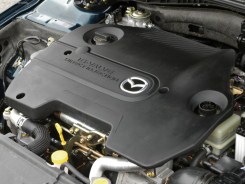
Mazda 6
There is no bad choice, so this time we can praise even the smallest 1,8S petrol engine that does a great job. The average consumption is about 6,5 - 7 liters of unleaded gasoline per 100 kilometers, according to factory data.
If you need a little more power, you can opt for 2,0 gasoline with 140 horses or the same diesel. At the top of the offer is 2,3 gasoline, but keep in mind that registration is much more expensive and consumption is higher, so we remain at 2,0 or 1,8 variants, which really provides a lot.
In the petrol variants 2.0 and 2.3, they also noticed a 4-speed automatic, and 2.3 - with four wheels, using a viscous coupling (only in the cross section of the real estate version and automatic transmission, power reduced to 162 hp).
The petrol engines of the Mazda 6 are similar. All developed by Mazda itself, and their concept is based on an aluminum block and head, a 16-valve, chain-driven DOHC system. Just because it is chain driven, it reduces the cost of tkz. “Big” service to a minimum, as it is only 200 km to check the condition of the chain. If it is to be replaced, a complete distribution system consisting of chains, sprockets, spanners and sliders must be replaced. The engine itself turned out well, there are no major problems, so it can be said that when combined with the gas, the petrol engine in the Model 000 is the most cost-effective solution.
After the restyling, the petrol engines with a volume of 2 and 2,3 liters are equipped with a six-speed manual transmission. In addition, the two-liter petrol engine has been boosted from 141 to 146 horsepower and it has a variable valve timing (which is from the start on the 2,3-liter versions). Optionally, these engines are available with a 5-speed automatic transmission, which has replaced the Activematic with a four-speed automatic.
Engines 1.8 and 2.0 do not have direct injection, so you can install a sequential LPG installation on them.
2,3 engine with variable valve opening control has more problems, it has a problem with increasing fuel consumption.
At the end of 2005, Mazda's Mazda 6 engine range was enriched with the most powerful MP variant, a 2.3-liter turbocharged direct-injection petrol engine that had 260 horsepower and 380 Nm of maximum torque. it had all-wheel drive (Haldek) via a 6-speed manual transmission. Compared to the civilian "six", it had a reinforced suspension and brakes, with a perfect 50:50 weight distribution.
Much more common are the 2000 cc diesel engines, also a product of Mazda itself. Generally they are great, but I would say that three things can be a potential problem for this engine, and can be very expensive.
The first problem is the famous floating flywheel with the clutch set. Both power versions carry such a set, it is best to replace the complete one, as the combination of replacing one without the other is almost not recommended. There are options to overhaul the clutch set as well as the flywheel, but it is not advisable to do so.
Another potential problem is large-scale service, which requires only high-quality parts, because if the belt breaks or skips, the least intake, if not exhaust, rocker valves will break. This engine does not forgive, so it pays to invest more money immediately in all elements of the set (gear belt, pulley, roller, hydro). The timing belt replacement interval is 120 km.
A third potential problem may be the nausea. Like all modern diesels, it suffers from poor fuel quality. Nozzles are on the hook, and the problem is that Mazda carries Denso manufacturer's nozzles. Unlike Bosch, which is present everywhere and has an extensive network of repairers and dealers, Denso is extremely demanding, so the number of repairer services is very limited. Even then, it is not possible to completely repair the nozzles, but only some of the parts.
After the Mazda 6 was restored, a diesel engine was upgraded, equipped with an unfortunate one particulate filter (DPF) and a six-speed manual transmission. The more powerful turbo diesel is boosted to 143 instead of 136 hp.
All Mazda 6s carry the same type of front brakes (plates and discs), which reduces the cost of maintenance as the build series is larger. There are no rules for how long they last, depending on the driving style and the quality of the parts.
Mazda 6 - Model History:
2002: Introduced the new Mazda 6 as a four-door sedan or five-door station wagon with seductive design and impressive build quality. Mazda offered 1.8-liter starting engines with 118 bhp, 2.0 with 139 bhp and 2.3 with 164 bhp petrol engines as well as turbo diesel 2.0 with 119 bhp and 136 bhp. The equipment packages carry the names S, TS, TS2 and Sport and all have good specifications. Diesel engines emit less gas than standard. Model presentation in sedan and sedan. The caravan joins with a few months delay.
2003: Offered 4WD.
2005: Restailing.
2006: MPS model with 2.3 turbo engine and 4 × 4.
2007: End of production of Mazda 6.
Mazda 6 - Problems and malfunctions
Before buying a Mazda 6 you should know
- interior, some owners complained about torn edges of the seat. This problem appeared only in dark shades of the interior and was mostly solved within the warranty period.
- electricity, there were phantom warnings "check engine“Due to a problem with the oil pressure sensor. In such cases, the sensor needs to be changed.
- If the Mazda 6 is parked downhill, with the front facing down, heavy rain can cause water to enter the luggage compartment. Check the boot for any signs of deterioration.
When looking at driving, the Mazda 6 stands alongside the Ford Mondeu or Honda Accord. It has good stability, lively engines and excellent driver's seat position. The 1.8 model takes higher turns to show the right face, but it's still fun and competent.
When buying, you won't have much to do with checking. Mazda has reached competitors with this car, and in some segments has outperformed them. As for the price, it is also solid in its class of half, so buying is recommended.
We will start with what is common to all models, namely brakes and trap. This car is not a maintenance problem because all the perishable ladder assemblies exist in the copy. For the front, the front shoulders often double in the side. One cannot specifically market the ball of the wheel, but goes in the composition of one of the forks. The erasers and buckles of the balance rod depart periodically, thanks to our paths. Power blocks are rarely injured on the back trap.
The Mazda 6 has rust problems before the restyling. Initially, the problem was very similar to the Ford Mondeo, 2000-2005, although both of these cars on the chassis have nothing in common. The bumpers and the rear door rust, which should be repaired soon after they appear, so that they do not spread. What is necessary to pay attention to is the protection of the bodywork. Unfortunately, Mazda rusts faster than its Japanese competitors, and they obviously haven't learned that lesson, because this is a flaw that has been dragging on for years. Therefore, it is recommended to do body protection in the lower part of the car.
Camshaft wear on diesel engines is usually due to the use of the wrong oil.
Alternator pulley hum (turbo diesel) - faulty bearing, and noise under the hood can be caused by a faulty air conditioning compressor, belts or vacuum pump.
Diesel engines with particle filter. The first diesel engines with a particulate filter, 2006, can cause a malfunction: Excessive loss of performance during the filter regeneration phase, warning light control flashing, power loss, possible black smoke emission… Remedy: reprogramming of the electronic engine management and / or filter replacement.
The gasoline engine may have the following problem: the engine failure light on the instrument panel illuminates, the engine is in forced mode and a P0440 error occurs when reading the computer. The problem may be a faulty EVAP valve, the EVAP valve needs to be replaced.
Electronic motor control. On models manufactured until November 2002, the risk of idling of the engine at idle or low speed when switching on the air conditioner. Consequence of installation problems.
In some vehicles manufactured in 2002, there was a problem with the engine cooling due to a fault in the engine cooler.
Mazda 6 2002 - 2003 clutch problems. Usually the culprit for the problem is the floating flywheel, there are mechanical problems with the clutch.
On some Mazda 6s made from January to June 2003, the brake fluid level indicator lights on the instrument panel. It is caused by a jamming of the float in the brake fluid reservoir.
Noise from the front brakes when the brakes are applied at low speed. A possible problem is the vibration between the brake lining and the discs. Change the front brake lining.
Shaking of front brakes. A possible problem is the distorted front brake discs, replacing the front wheels and discs.
Gas tank. It is made of plastic (normal). On models manufactured between February 2002 and February 2004, it may be exposed to overheating due to the proximity of the exhaust pipe. The risk of deformation and in extreme cases, perforation, causes fuel leakage. September 2004: Shield installed.
Air conditioning - the device is not the most durable.
The speedometer and tachometer hands will reach the end of the scale when you try to start the engine - if the problem is the battery.
The 2002 models have problems with the front head restraints.
Code Mazda 6 manufactured until June 2005, common failure of window motor failure.
Air conditioning control problems. In cold weather, it is impossible to heat the interior of the vehicle if the temperature for the device is set below 23 ° C. Problems with the outside temperature sensor.
Exterior mirrors. On the 2002-2003 models, the mirror vibrates.
Mazda 6 - The most common failures - Link
The Mazda 6 has character, style, excellent quality and shoots for the highest ranking in this class of car.
Cheap, powerful and dynamic engines make it an attractive package, while a spacious and smart cabin makes it a practical car. The predecessor was annoying and bad to drive, while the new 6 will dispel all your prejudices about Mazda. This is Mazda's best model and deserves success.
In summary, the Mazda 6 is a modern concept and successful model of the Japanese manufacturer, where reliable mechanics are packed into an attractive body. It is not overly expensive to maintain. If you choose the right half copy, it will certainly not disappoint you.
Although the diesel engine is reliable and with excellent performance, the recommendation is a gasoline engine, as it eliminates large service, the problem of complicated nozzles and a much cheaper clutch. With the installation of gas, it becomes economical like diesel.
Mazda 6 price - used car review
Recommendation of similar texts:

Hi there, I am Mladen and I am an auto enthusiast. I started this blog years ago to help like minded people share information about latest cars, car servicing ideas, used car info, exotic cars, and auto technology. You will find helpful articles and videos on a wide variety of cars - Audi, Mercedes, Toyota, Porsche, Volvo, BMW and much more. Ping us if you have anything cool to share on latest cars or on how to make older cars more efficient, or just want to say hi!




